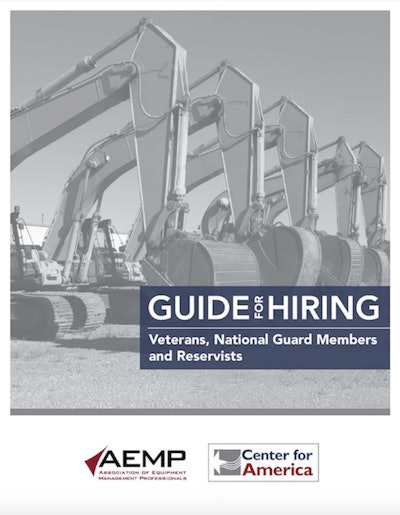

He had run dozers while on active duty from 1999 to 2003, so he called an uncle who worked in construction to see about a job. That began his construction career, which has resulted in his managing a $34 million heavy-equipment fleet for Hawkins Construction Company in Omaha, Nebraska.
Now at age 38, he’s hoping to find other young veterans who are like he was, who may not realize the opportunities the construction industry provides.
“I’m looking for somebody that has the will to learn,” he says. “If I can get a young Marine in here … he’s got drive. He knows what it’s like to show up. He knows what it’s like to be accountable.”
Though the numbers would appear to be in his and other construction firms’ favor – it is estimated that 200,000 personnel leave the military each year and 1.8 million veterans are in minimum-wage jobs below their skill levels – finding veterans for construction industry openings has proved difficult.
The Association of Equipment Management Professionals hopes to change that. The nonprofit organization has been tackling the issue since 2016 and recently produced a guide to help the construction industry tap into a resource that many believe is being overlooked.
 Marianne Watson
Marianne Watson“Their skill sets are not being recognized or understood,” says Marianne E. Watson, retired Army brigadier generaland former director of manpower and personnel for the National Guard Bureau. “They don’t know that you have job opportunities available.”
Watson is the director of outreach for the nonprofit Center for America, which provides free resources to help employers hire veterans, and has been working with AEMP to develop the “Guide for Hiring Veterans, National Guard Members and Reservists.”
AEMP pinpointed workforce development as a critical issue for its members in 2014. In 2016, the Work Force Development Committee was formed and decided to focus on developing a veterans’ hiring guide, according to Rachel Connor, AEMP staff liaison to the committee.
“What the committee was struggling with was there’s so many resources,” Connor says, referring to the plethora of organizations that claim to help job-seeking veterans. “Where do you start? Who’s legit? Who’s successful?”
With Watson’s help, the committee was able to home in on the top organizations for matching veterans and employers.
But that’s just a small part of the battle. The bigger issue is getting the word out to veterans, Guard members and Reservists, because many of them are not skilled in civilian job searching.
“Service members don’t create resumes while they’re in the service,” Watson said during a presentation in March at AEMP’s annual conference in Orlando. “Most have never had job interviews.”
But what they lack in polished job-seeking skills, they make up for in a strong work ethic and experiences not typical for their age, she says.
“Even your junior personnel who leave after one assignment in the Army has been responsible for small teams, their welfare, their safety – a lot more than your average young millennial,” Watson said.
The trick is finding them. They aren’t likely to show up on your doorstep asking for work.
 Dan Kunce
Dan Kunce“You have to put in the effort to find them,” says Kunce, who has hired about a dozen veterans for equipment operation and tech jobs.
The key is connecting with local Reserve and Guard units and military bases. He’s attended career fairs for military personnel. He has also approached ROTC units at high schools to discuss construction careers.
“You have to network to find veterans,” Watson said.
Watson recommends directing a company’s human resources personnel to establish that network by contacting local units of the Army National Guard, which has 340,000 active members nationwide. There are also a variety of organizations that help match veterans and employers, such as the U.S. Chamber of Commerce’s Hiring Our Heroes, the Center for America’s Jobs for America’s Heroes, and Corporate America Supports You, which says it made 8,375 veteran hires in 2017.
In attracting veterans to your company, she recommends ads that discuss what career opportunities you have and that the ad focus on required skills rather than credentials. She explains that military experience can be difficult to translate into civilian credentials, but in many cases, the military has provided training that would be comparable.
Kunce recalls that when he came out of the Marine Corps, he was faced with having to become an apprentice for four years at low pay through the local union. But thanks to his equipment operating experience in the military, he was able to test out of the apprentice program and go to work immediately at a higher pay level as a journeyman.
Watson recommends companies have an onboarding process for equipment operators so those with military experience but not civilian credentials are not being slotted for entry-level jobs. She also recommends that process be prompt. “If the process is too long, they might go elsewhere,” she says.
When screening and interviewing candidates, companies should not expect civilian references or a polished resume or interviewing style. Companies should be able to provide clear information about what a career path at their business looks like. They should consider creating a brochure to give to candidates and to provide to local military organizations, units and bases.
In Kunce’s case, his hires are often inexperienced, because his company prefers to train them.
“All of the military I have hired have not had much experience in what I need them for,” he says. “That’s worked out so far. Ninety percent of them we’ve built into something.”
“They’re coming out with not a whole lot of idea of what they want to do,” he explains. “They don’t have a direction, so we’re pushing them into a direction that we think they’re good at. … Being good servicemen that they are, they keep showing up every day and working.”
Kunce’s military experience has helped Hawkins with the company’s recruitment, but he says that, like any hiring for construction openings in today’s tight labor market, he faces the same challenges as other fleet managers.
At a recent military career fair, about 40 candidates stopped by his booth. Of those, about half were qualified, and of that amount, none expressed further interest in the openings.
Such challenges, however, only mean companies need to work harder at finding veterans, he says. He’s optimistic that military hiring will improve, especially as more former military personnel rise through the construction ranks. He’s also certain that the military will continue to produce men and women who, though they may not have specific job credentials, will be hardworking, dependable employees with a strong work ethic.
“The Marine Corps disciplined me,” says Kunce, who started out pumping concrete and rose to fleet manager at Hawkins, which employs about 400 workers. “They taught me how to get up in the morning and be accountable. … That has gotten me further than my operating skills did.”














